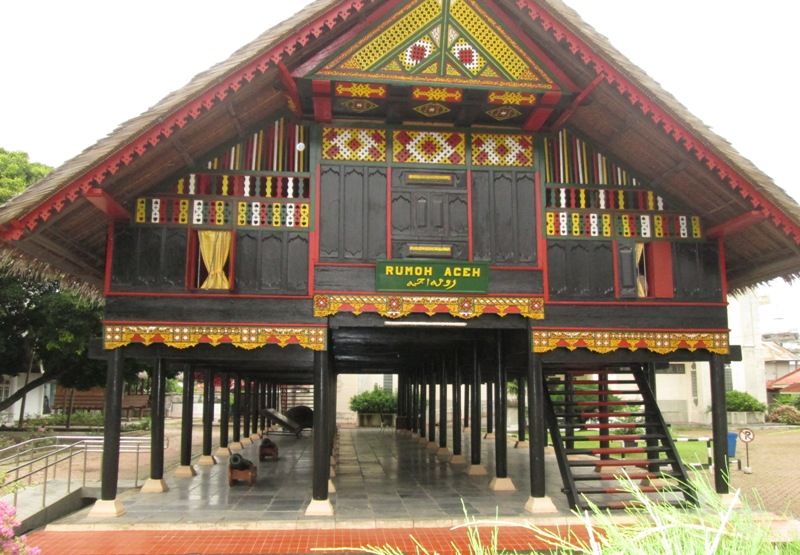House of Aceh
Rumoh Aceh is a form of residence of the people of Aceh past and now almost lost, only left in a few places in Aceh. This house has been immortalized in Banda Aceh (complex of Aceh Museum Museum) and in Taman Mini Indonesia Indah (TMII) and Rumah Cut Nyak Dhien in Desa Lampisang, 10 km from the center of Banda Aceh City. Inside the House of Aceh located in the complex of the Museum of Aceh there are many items of past relics that are often used by the people of Aceh such as pedeung on jok, jingki, jars, berandam or place to store rice etc. If you go to Banda Aceh do not forget to come visit and witness the condition of traditional house of Aceh past. This Aceh house consists of 44 columns and has 2 front and back stairs.
1.Asal
The belief of an individual or a living society has a significant influence on the architectural form of the building, the house, created. This can be seen in the architecture of Rumoh Aceh, Province, Nanggrou Aceh Darussalam. In general Rumoh Aceh is a stilt house with a pole height between 2.50 - 3 meters, consisting of three or five spaces, with one main room called vines. Rumoh with three rooms has 16 columns, while Rumoh with five spaces has 24 columns. Modifications from three to five spaces or vice versa can be done easily, just add or remove the existing on the left or right side of the house. This section is usually called seramoe likot or back porch and seramoe reunyeun or porch steps, which is the entrance to the House which is always located in the east. The main door of Rumoh Aceh is always lower than the height of adults. Usually this door height is only 120-150 cm in size so that everyone entering Rumoh Aceh should bow down. However, once inside, we will feel the space is very roomy because in the house no furniture in the form of chairs or tables. Everyone sits cross-legged on a ngom mat (of similar material that grows in the swamp) which is covered with pandanus mats. Rumoh Aceh is not just a shelter, but an expression of belief in God and adaptation to nature. Therefore, through Rumoh Aceh we can see the culture, lifestyle, and values that are believed by the people of Aceh.
Parts of Rumoh Aceh
At the bottom of the house is called yubmoh which can be used for storing various objects, such as Jeungki (rice pestle), which is used as a place for children to play and also often used swing place for baby children.
• The front room or called seramoe Keu (front porch), this room is plain without a room that serves as a men's living room, study room to teach boys at night or during the day also male guest bed. And at certain moments like the marriage ceremony this room also serves as a joint banquet.
• The middle room or seungamoe teungoh is the core of the rumoh of Aceh and slightly higher than seramoe keu it is called rumoh inong (the main house) and this place is considered sacred because it is very personal. In this middle room there are two booths or rooms facing each other. Both rooms are for the bed of the head of the family or the owner of the house, if there is a newly married girl then he will occupy this room and the parents will move to anjong.
• Room Rear or called seramoe Likoet (rear porch), this room is also plain without a room that serves as a women's living room, the same area with seramoe keu this room for women is also used for study rooms for girls and when the guests who Come women then the place of musyawarah or bed of the guests is also a place to eat together for women so in Aceh male and female guests are not put together
Aceh House Building to strengthen does not use nails, but using a binder of rope, rattan (awe) for roof ties generally from the rumbia and some are using coconut leaves and when inside the house never felt hot sauna in the house is always cold And when the heavy rain never sounds noisy. Aceh House if not using nails and made of wood but can last up to hundreds of tahun.Pengaruh conviction of the people of Aceh to the architecture of the house can be seen in the orientation of the house that always shaped elongated from east to west, ie the front facing east and the inner or back The sacred is in the west. The West's direction reflects the efforts of the Acehnese to build an imaginary line with the Ka'bah in Mecca. Moreover, the influence of beliefs can also be seen in the use of its even numbered pillars, its odd number of rooms, and its odd numbered children. Aside from being a manifestation of belief